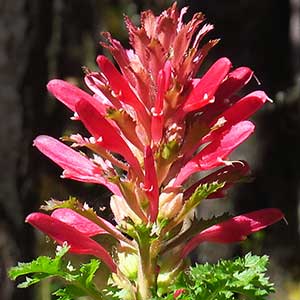Pedicularis densiflora
Pedicularis groenlandica
Indian warrior, warrior's plume
bull elephant's-head, elephant's head, elephant's head pedicularis, elephant's-head lousewort, elephant-head lousewort, pédiculaire du groenland
basal 1–10, blade lanceolate, 30–200 x 20–70 mm, 2(or 3)-pinnatifid, margins of adjacent lobes nonoverlapping or extensively overlapping distally, 1-serrate, surfaces glabrous, hispid, or downy;
cauline 4–20, blade lanceolate, 15–250 x 5–100 mm, 2-pinnatifid, margins of adjacent lobes nonoverlapping or extensively overlapping distally, serrate, surfaces glabrous, hispid, or downy.
basal 5–20, blade lanceolate, 20–150 x 5–25 mm, 1-pinnatifid or slightly 2-pinnatifid, margins of adjacent lobes nonoverlapping, 1- or 2-serrate, surfaces glabrous;
cauline 3–31, blade lanceolate, 10–150 x 1–25 mm, 1-pinnatifid, margins of adjacent lobes nonoverlapping, serrate, surfaces glabrous.
simple, 1–5, exceeding basal leaves, each 10–50-flowered;
bracts lanceolate to trullate, 10–35 x 3–5 mm, undivided or 1-pinnatifid, proximal margins entire, distal 1- or 2-serrate, surfaces glabrous.
simple, 1 or 2, exceeding basal leaves, each 20–75-flowered;
bracts linear to trullate, 5–10 x 2–10 mm, undivided to pinnatifid, margins entire, serrate, or 2-serrate, surfaces glabrous.
2–4 mm.
0.5–1 mm.
calyx 9–18 mm, downy to tomentose, lobes 5, triangular, 3–4 mm, apex entire, ciliate;
corolla 23–43 mm, tube dark red, purple, or orange-yellow, rarely white, 8–18 mm;
galea dark red, purple, or orange-yellow, rarely white, 15–25 mm, beakless, margins entire medially and distally, apex straight;
abaxial lip dark red, purple, or orange-yellow, rarely white, 8–15 mm.
calyx 3–5 mm, glabrous or hispid, lobes 5, deltate, 0.5–1.5 mm, apex entire, glabrous;
corolla 5–8 mm, tube purple, rarely white, 3–5 mm;
galea pink to purple, rarely white, 1.5–3 mm, beaked, beak coiled, 5–18 mm, base curving, margins entire medially and distally, apex not surrounded by abaxial lip, axis of coil nearly horizontal;
abaxial lip pendulous, purple, rarely white, 2–5 mm.
= 16.
= 16.
Pedicularis densiflora
Pedicularis groenlandica
Scarlet corollas with an undomed, toothless galea and two- or three-pinnatifid leaves are diagnostic of Pedicularis densiflora. This species occurs in forested subalpine regions of southern Oregon, western slopes of the Sierra Nevada, and the Coast Ranges of California south to Baja California. Herbarium records indicate northern populations of P. densiflora occur at higher elevations than do more southern populations.
(Discussion copyrighted by Flora of North America; reprinted with permission.)
Pedicularis groenlandica has a domed galea, a long, curved beak, and relatively large lateral lobes of the abaxial lip that remarkably resemble the head, trunk, and ears of an elephant. Pedicularis groenlandica is the most widely distributed Pedicularis species in North America; it occurs from the southern Sierra Nevada and southern Rocky Mountains well into the Arctic and Greenland.
Pedicularis attollens and P. groenlandica are sympatric in the Sierra Nevada and the Cascades of central and southern Oregon and can be difficult to distinguish. Pedicularis groenlandica is distinguished by the size and orientation of the beak and color of the corolla; the beak is over twice the length of the beak of P. attollens and is oriented more horizontally compared to the upturned beak of P. attollens. Beak orientation is very difficult to ascertain in herbarium material due to flattening; beak length is a better character on herbarium specimens. The corollas of P. groenlandica are purple with lighter purple to pinkish abaxial lips, whereas the corollas of P. attollens vary from pink to light pink often with conspicuous dark purple spots on the galeas. White-flowered forms of P. groenlandica (forma pallida Lepage) are occasionally seen.
(Discussion copyrighted by Flora of North America; reprinted with permission.)


